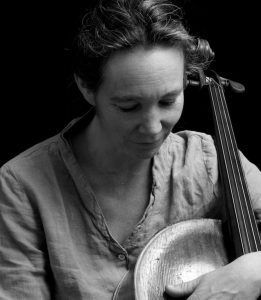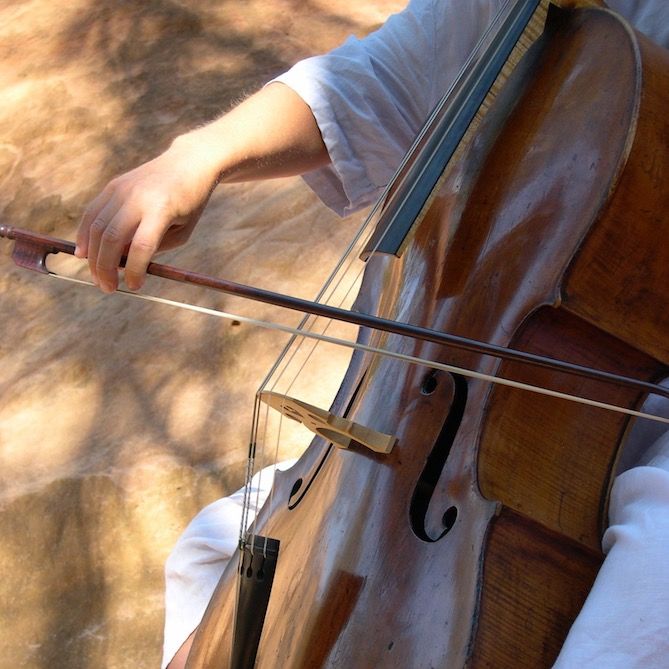The Breath
“The bow must be a living thing at all times, and all living things need to breathe” – Steven Isserlis, cellist.
For me, the breath is the thing that binds all of this together. No-wonder it is at the root of so many spiritual practices! It is inspiration and expression, tension and release, taking in and letting go, expansion and contraction. It is not ‘ours’ though it passes through us, and it connects us with ourselves, our bodies and the audience. With all living things. The ocean breathes, trees breathe….It is everything we are and everything music is. When we are aligned and in harmony, we feel as if we are being breathed, just as we can, in performance, feel like the music is playing us. Working with the breath makes and builds these vital connections.
Breathing Bow Exercise One: The Arms’ Response to the Breath
Finding the seeds of movement in bowing.
Stand comfortably with your arms hanging loosely by your side. Breathe slowly and deeply, being aware of the breath filling and emptying the front, sides and back of the rib cage. Bring your awareness to your arms and observe any response they may have to the expansion and contraction. If you feel the movement, amplify it, allowing the arms to float up and away from the torso on the inhalation, and fall back on the exhalation. You may also observe a slight rotation in the arms as you breathe in and out.
Breathing Bow Exercise Two: Cello Wings
Opening the arms out like wings on the inhalation and folding back on the exhalation.
(NB. This exercise is unnatural in one way as we almost never prepare to play with an exhalation.)
Seated with the cello, start at the heel at the bottom of an exhale. As you inhale and fill the rib cage, allow the breath to lead your arm as it opens out like a wing in response to the expanding rib cage. At the tip of the bow, pause and enjoy the tension of the full rib cage. Allow the exhale to lead your arm in folding back towards your body on the return to the heel. Notice the tension as the arms open and the release as they fall back with gravity and amplify this. The down bow will become slower and deeper, and the up bow faster and lighter.
Breathing Bow Exercise Three: The Curved Bow
Using the breath to find the curve of the note and the bow.
Inhale to prepare. Start at the heel with a full rib cage. Exhale for three counts on the down bow and allow the bow to move in response to the release, coming to rest at the end of the out breath (probably somewhere near the balance point). Then inhale for three counts as your arms open away from your body, and your bow to moves towards the point. Let the following exhale lead your bow change, so you exhale for three counts on the up-bow, coming to rest again near the middle, and inhaling for another three counts as you move towards the heel. Always let the breath lead the movement. Observe the difference in bow speed and contact point as you gather and lose momentum.
Variations
Finding the breath in the rhythmic pattern.
How we choose to practice depends on the music we are playing. For example: If we are playing a piece in three (the slow movement of Dvorak concerto for example) it is helpful to practice breathing out for two counts, coming to rest, then breathing in for one on both down and up bows. This corresponds to the minim and crotchet rhythm. If we are playing a passage in 4, we may look to see where the impulse, the resting place and the preparation are in the musical shape (after the three if it is a dotted minim and a crotchet or after the two if it is two minims).
Breathing Bow Exercise Four: Vibrato
Using the breath to link up the right and the left sides of the body.
Do the exercises above on a scale and allow the left arm to release and come to rest by your side exactly as the bow arm does on the exhalation. Then, on the inhalation allow the arm to open out (always following the expansion of the rib cage) and notice how the width and intensity of the vibrato naturally mirrors the bow speed.
“Breath is the bridge which connects life to consciousness, which unites your body to your thoughts.” – Thich Nhat Hanh
My teacher, Timothy Eddy, once said to me ‘Ruth, something inside you has to move before you are moved to play.’ In a world where so much is taken at face value, from the outside – in, the breath is a vital teacher, reminding us to be embodied, to live and play from the inside-out.
The next Breathing Bow retreat will be held in Provence with Ruth Phillips and Jane Fenton. 16-20 October 2018.
_________________________________________________________________
 Ruth Phillips was Born in London in 1964 and studied at the Yehudi Menuhin School with William Pleeth, and in Dusseldorf with Johannes Goritzki. In 1990, Ruth left a successful career with the Chamber Orchestra of Europe to continue her studies with Timothy Eddy at the State University of New York where she received her Masters’ degree in performance.
Ruth Phillips was Born in London in 1964 and studied at the Yehudi Menuhin School with William Pleeth, and in Dusseldorf with Johannes Goritzki. In 1990, Ruth left a successful career with the Chamber Orchestra of Europe to continue her studies with Timothy Eddy at the State University of New York where she received her Masters’ degree in performance.
Described as a ‘consummate coach’, Ruth draws on her training as a Voice Movement Therapist, and on many years’ work with yoga, mindfulness, meditation and Non-Violent Communication. Her generous spirit and organic approach to playing has helped people all over the world suffering from tension and stage fright find presence, ease and inspiration. Ruth runs individual Breathing Bow retreats from her home in Provence and has run workshops at the European String Teacher’s Association conference, the Royal Northern College of Music and the Royal Scottish Academy of Music. With her colleagues, Alexander teacher and cellist Dale Culliford, and yoga teacher and cellist Jane Fenton, Ruth runs group Breathing Bow retreats throughout Europe.
Ruth has an active life as a solo, orchestral and chamber musician on both baroque and modern cellos. Passionate about all types of music, she enjoys regular collaborations with folk singers, The Brothers Gillespie, and the Indian cellist Saskia Rao. She is co-principal cellist of Opera Fuoco in Paris. Ruth’s writing on breath and performance has appeared in many publications including The Strad and BBC music magazines, and her book, ‘Cherries from Chauvet’s Orchard’ was shortlisted for the Guardian women’s memoir award. She was involved in John Beder’s 2016 documentary on stage fright, ‘Composed’, and her playing of Bach is featured on the soundtrack.
http://thebreathingbow.com








